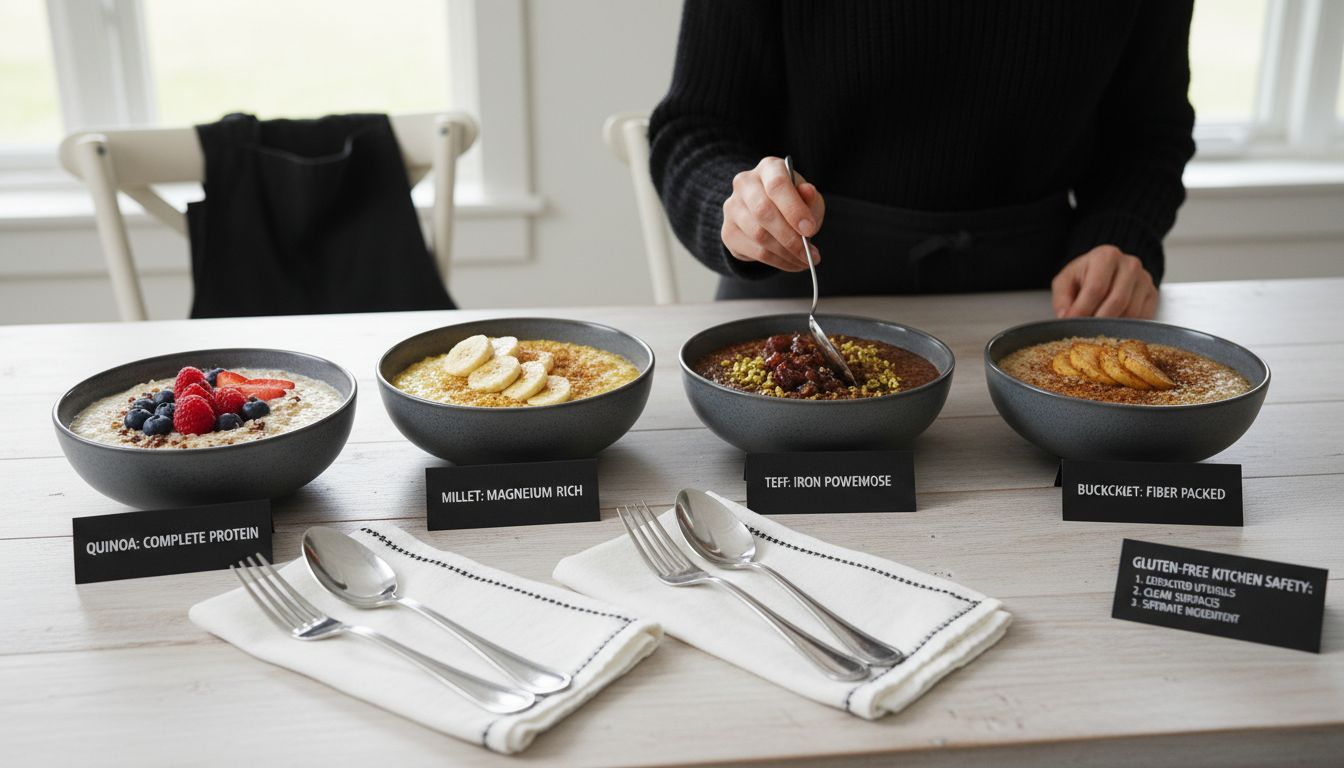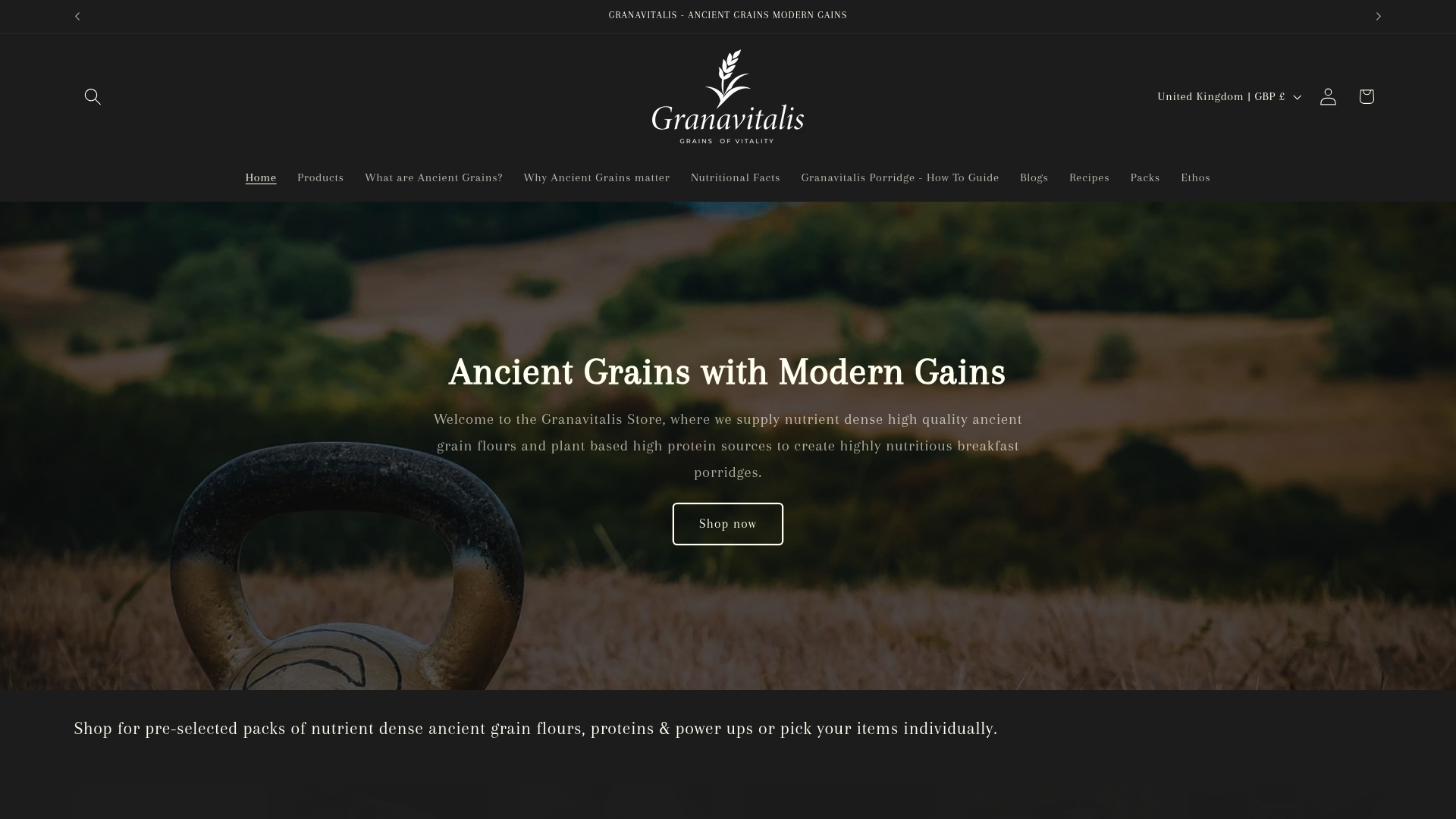
Complete Guide to Gluten-Free Porridge
Share
Did you know that foods labeled as gluten-free must contain just 20 parts per million or less of gluten for safety? With more people living with coeliac disease and gluten sensitivities, breakfast choices can feel confusing. Understanding what truly counts as gluten-free porridge reveals a world of healthy and delicious grains waiting to be enjoyed—each with its own taste and nutritional benefits, far beyond traditional oats or wheat.
Table of Contents
- Defining Gluten-Free Porridge And Common Misconceptions
- Ancient Grains And Modern Gluten-Free Options
- Health Benefits And Nutritional Power Of Porridge
- Safe Preparation And Avoiding Cross-Contamination
- Common Pitfalls And How To Optimise Flavour
Key Takeaways
| Point | Details |
|---|---|
| Gluten-Free Definition | Gluten-free porridge is specifically designed for those with gluten sensitivities and must contain 20 ppm or less of gluten to be considered safe. |
| Diverse Grain Options | A variety of naturally gluten-free grains, such as quinoa, amaranth, and millet, can be used to prepare nutritious porridge. |
| Avoiding Cross-Contamination | Proper kitchen practices are essential to prevent cross-contamination in gluten-free porridge preparation, including using dedicated utensils and storage. |
| Enhancing Flavour | Toasting grains and experimenting with diverse ingredients can elevate the taste and texture of gluten-free porridge, making it more enjoyable. |
Defining Gluten-Free Porridge and Common Misconceptions
Gluten-free porridge represents a nutritious breakfast option specifically designed for individuals with gluten sensitivities, coeliac disease, or those choosing to avoid gluten in their diet. According to cuh.nhs.uk, the term ‘gluten-free’ has a precise legal definition: foods containing 20 parts per million (ppm) or less of gluten, which is considered safe for those with coeliac disease.
Contrary to popular misconception, gluten-free porridge is not about eliminating grains entirely, but rather selecting naturally gluten-free alternatives. aoecs.org highlights several excellent grain options for preparing gluten-free porridge, including:
- Amaranth
- Buckwheat
- Corn
- Millet
- Quinoa
- Rice
- Sorghum
- Teff
However, a critical consideration is cross-contamination during processing. Even naturally gluten-free grains can become contaminated if processed in facilities that handle wheat, barley, or rye. This means consumers must carefully check packaging and look for certified gluten-free labels to ensure complete safety. For individuals with coeliac disease or severe gluten sensitivity, this isn’t just a dietary preference but a medical necessity.
Understanding gluten-free porridge goes beyond simply avoiding wheat. It’s about exploring a diverse world of nutrient-rich, naturally gluten-free grains that offer unique flavours and remarkable health benefits. How to Make Gluten-Free Porridge: Nutritious and Easy Recipe can provide more detailed insights into preparing these delicious, safe breakfast options.
Ancient Grains and Modern Gluten-Free Options
Gluten-free porridge has witnessed a remarkable transformation with the revival of ancient grains, offering nutritious alternatives that transcend modern dietary restrictions. According to wheatfoods.org, ancient grains like millet, sorghum, and teff have been dietary staples for thousands of years, providing diverse flavours and exceptional nutritional profiles that make them perfect for gluten-free porridge.
Whole Grains Council highlights several remarkable gluten-free ancient grains ideal for porridge preparation:
- Quinoa: A protein-packed pseudo-grain
- Amaranth: Rich in minerals and amino acids
- Teff: Tiny grain with massive nutritional punch
- Millet: Alkaline and easily digestible
- Sorghum: Versatile and nutrient-dense
These ancient grains represent more than just gluten-free alternatives. They embody a return to traditional, whole-food nutrition that predates industrialised food processing. Each grain brings unique textures, flavours, and nutritional benefits that modern processed cereals simply cannot match.
 The Hidden Cost of “Modern” Grains — And Why Ancient Grains Belong Back offers deeper insights into why these grains are making a powerful comeback in contemporary diets.
The Hidden Cost of “Modern” Grains — And Why Ancient Grains Belong Back offers deeper insights into why these grains are making a powerful comeback in contemporary diets.
Modern gluten-free options extend beyond traditional grains, incorporating innovative processing techniques that maintain nutritional integrity while catering to diverse dietary needs. From creating creamy porridges with quinoa to experimenting with teff’s nutty undertones, these ancient grains prove that gluten-free eating can be both nutritionally sophisticated and profoundly delicious.
Here’s a summary of key ancient grains used in gluten-free porridge:

| Grain | Notable Nutrients | Texture & Flavour |
|---|---|---|
| Quinoa | Protein Magnesium |
Light, slightly nutty |
| Amaranth | Calcium Magnesium |
Creamy, mildly earthy |
| Teff | Iron Calcium |
Fine, sweet, nutty |
| Millet | Antioxidants | Fluffy, mildly sweet |
| Sorghum | Fibre B vitamins |
Chewy, subtle sweetness |
| Buckwheat | Magnesium Fibre |
Soft, robust, earthy |
Health Benefits and Nutritional Power of Porridge
Porridge isn’t just a comforting breakfast—it’s a powerhouse of nutrition that can transform your daily health routine. Brown Health highlights how ancient grains used in porridge, such as quinoa and amaranth, are packed with high-quality protein, fiber, and essential minerals like iron and magnesium, providing sustained energy throughout the morning.
The nutritional profile of porridge makes it an extraordinary meal choice. Each grain brings unique benefits:
- Quinoa: Complete protein with all essential amino acids
- Amaranth: Rich in calcium and magnesium
- Teff: Exceptional iron content
- Millet: High in antioxidants
- Buckwheat: Supports heart health
Wheat Foods particularly emphasises teff’s remarkable nutritional density, noting its high mineral content, especially iron and calcium. This tiny grain can contribute significantly to bone health and help prevent iron deficiency—a common concern for many individuals, particularly those following plant-based diets.
Beyond individual nutrients, porridge represents a holistic approach to nutrition. By incorporating protein-packed porridge techniques, you’re not just eating a meal—you’re investing in your long-term health, supporting muscle recovery, stabilising blood sugar, and providing your body with sustained, clean energy that can improve cognitive function and overall wellbeing.
Safe Preparation and Avoiding Cross-Contamination
Safe gluten-free porridge preparation requires meticulous attention to detail and understanding of potential contamination risks. aoecs.org emphasises the critical importance of preventing cross-contamination by using separate cooking utensils and dedicated preparation areas specifically for gluten-free foods.
Key strategies for maintaining a gluten-free preparation environment include:
- Designate separate chopping boards
- Use dedicated cooking utensils
- Clean kitchen surfaces thoroughly
- Store gluten-free ingredients separately
- Use individual storage containers
- Wash hands before food preparation
Cambridge University Hospitals provides crucial guidance on gluten-free standards, noting that foods labeled ‘gluten-free’ must contain 20 parts per million (ppm) or less of gluten. This stringent requirement means carefully checking not just primary ingredients, but all additives and potential sources of contamination.
For individuals with coeliac disease or severe gluten sensitivity, preparation isn’t just about convenience—it’s a health imperative. Understanding Gluten-Free Ancient Grains Guide can provide additional insights into selecting and preparing grains that meet the highest safety standards, ensuring your porridge is not just delicious, but completely safe for consumption.
Common Pitfalls and How to Optimise Flavour
Gluten-free porridge can be a culinary adventure, but many home cooks encounter challenges when attempting to create a delicious and satisfying meal. Wheat Foods reveals a game-changing technique: toasting grains like amaranth before cooking to unlock their hidden nutty flavours and transform an ordinary breakfast into an extraordinary experience.
Common pitfalls that can compromise your porridge’s taste and texture include:
- Overcooking grains, leading to mushy consistency
- Using bland liquid bases
- Skipping seasoning and flavour enhancers
- Neglecting textural variety
- Limiting grain selection
Whole Grains Council encourages culinary creativity by experimenting with diverse ancient grains like quinoa, teff, and millet. Each grain introduces unique flavour profiles and textures, preventing monotony and elevating your porridge from a simple morning meal to a gourmet experience. Combining multiple grains can create complex, layered taste sensations that keep your breakfast exciting and nutritionally diverse.
To truly optimise your porridge, consider adding natural flavour boosters like protein-packed porridge techniques that incorporate nuts, seeds, and plant-based protein powders. These additions not only enhance taste but also provide additional nutritional benefits, transforming your morning porridge into a powerhouse of flavour and wellness.
Discover the True Power of Gluten-Free Porridge for Your Wellbeing
Navigating gluten sensitivities or coeliac disease often leaves you wondering how to enjoy a nourishing breakfast without risking health or taste. Gluten-free porridge made from ancient grains offers a satisfying, nutrient-rich solution that fuels your body and supports long-term wellness. At Granavitalis, we understand these challenges and offer a carefully curated range of Gluten Free Flours – Granavitalis inspired by nature’s finest grains to bring wholesome breakfasts back to your table.

Transform your mornings with ingredients that respect tradition and embrace modern health needs. Explore our selection and learn how to craft porridge that is not only safe from cross-contamination but also rich in protein, fibre, and essential minerals. Start your journey to better breakfast choices today by visiting Granavitalis and discover ways to enhance your recipes with our All Flours – Granavitalis. Fuel your day with purpose and make every bowl count.
Frequently Asked Questions
What is gluten-free porridge?
Gluten-free porridge is a nutritious breakfast option made from grains that do not contain gluten, suitable for individuals with gluten sensitivities or coeliac disease.
What grains can be used to make gluten-free porridge?
Commonly used grains for gluten-free porridge include amaranth, buckwheat, corn, millet, quinoa, rice, sorghum, and teff. These alternatives provide unique flavors and nutritional benefits.
How can I prevent cross-contamination when preparing gluten-free porridge?
To prevent cross-contamination, use separate cooking utensils, dedicated preparation areas, clean kitchen surfaces thoroughly, and store gluten-free ingredients separately from those containing gluten.
What are the health benefits of gluten-free porridge?
Gluten-free porridge is rich in essential nutrients such as protein, fiber, iron, and magnesium, offering sustained energy, supporting heart health, and contributing to overall well-being.
